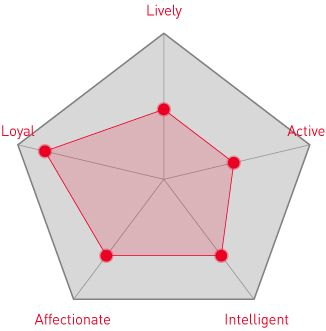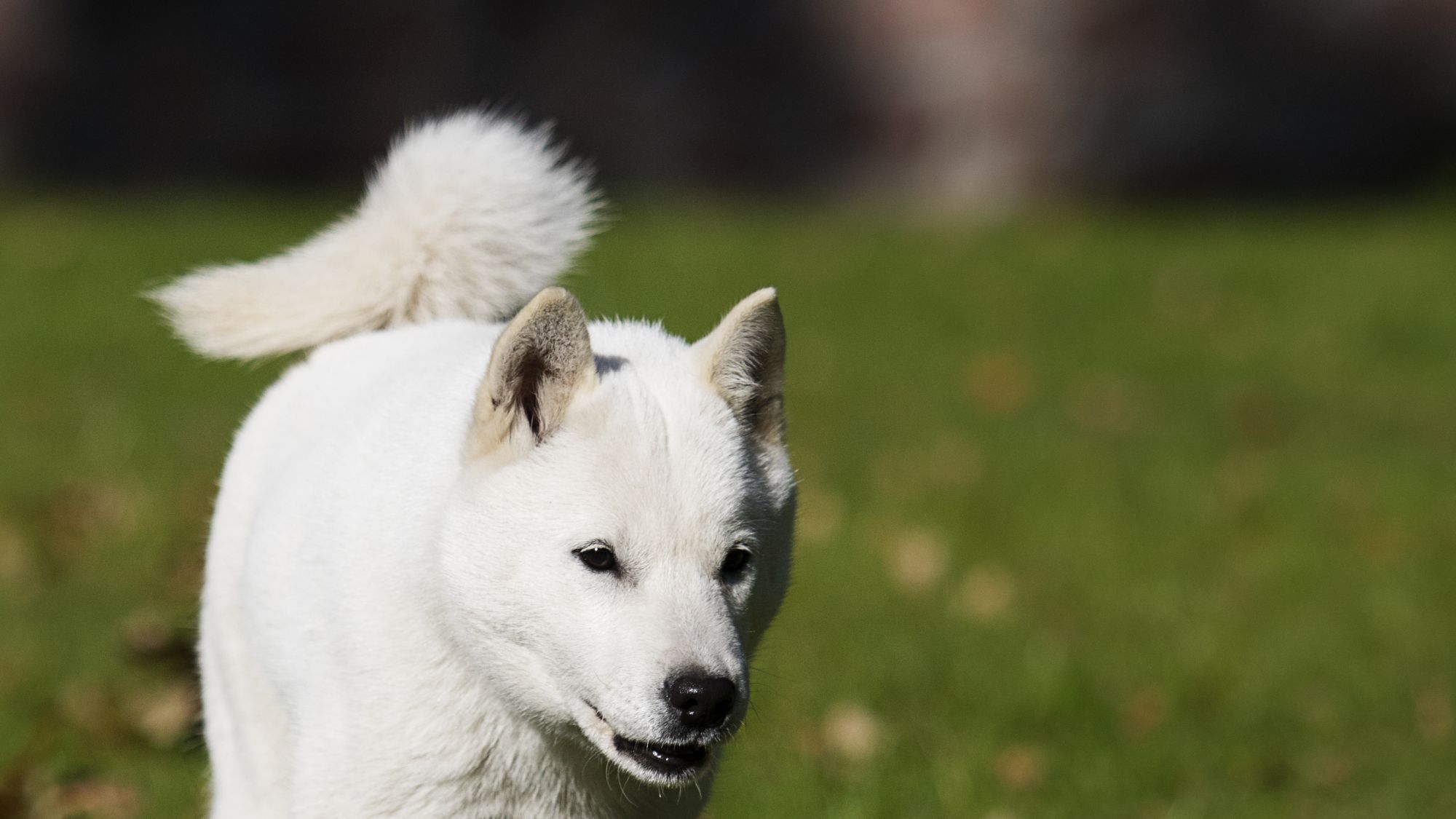
Let's talk Hokkaidos
Playful, affectionate, but always on high alert, the Hokkaido is a Japanese Spitz-type dog with a hunting heritage. They have evolved into family-friendly dogs who are incredibly devoted to their owners—but fearlessness and resourcefulness are two great qualities that remain a part of the Hokkaido today. With the right training, this medium-sized dog can be a wonderful playmate to older children. Hokkaidos have an endless supply of energy and will thrive as part of an active family to whom they can stay close.
Official name: Hokkaido
Other names: Dō-ken, Ainu-ken, Seta, Ainu dog, Hokkaido-Ken
Origins: Japan

| Drooling tendencies: |
|
Warm weather? |  |
| Shedding level: |  |
Suited to apartment living? |  |
| Physical activity needs (high, low, medium) *: | Medium | Family pet? * |
 |
| Compatibility with other pets: |  |
Can stay alone? * |  |
* We advise against leaving pets alone for long stretches. Companionship can prevent emotional distress and destructive behaviour. Speak to your veterinarian for recommendations.
Every pet is different, even within a breed; this snapshot of this breed’s specifics should be taken as an indication.
For a happy, healthy and well-behaved pet, we recommend educating and socialising your pet as well as covering their basic welfare, social and behavioural needs.
Pets should never be left unsupervised with a child.
All domestic pets are sociable and prefer company. However, they can be taught to cope with solitude from an early age. Seek the advice of your veterinarian or trainer to help you do this.


| Baby age: | birth to 2 months |
| Puppy age: | 2-12 months |
| Adult age: | 1-7 years |
| Mature age: | 7-10 years |
| Senior age: | from 10 years |
1/7
Get to know the Hokkaido
All you need to know about the breed
The Hokkaido has a public and private persona. On the street, this Japanese breed carries themselves in a dignified manner. Their well-proportioned physique can draw stares from strangers, which they may be too cool to notice. Behind closed doors, they become devoted and protective guard dogs. Who doesn’t love a canine with a dual personality?
One of six breeds native to Japan, the Hokkaido was previously used to hunt bears and wild boar by their owners. Hokkaidos’ muscular physique equals stamina and strength, which they gracefully control, so long as their exercise needs are being met.
Hokkaidos require a confident owner who will take the lead, training them to temper their strong-willed streak. If your Hokkaido gets a whiff that the boss role is up for grabs, it’s game over. But this is a highly intelligent breed, so when you take the lead, they instantly respect hierarchy.
Though the breed has evolved to be domesticated, your Hokkaido should always be supervised around other dogs and small children. Pets such as hamsters and guinea pigs may be too much temptation for the breed so it’s best to avoid any ... unpleasantness, shall we say?
This breed prefers to stay close to their owners and is often wary of strangers. Early socialisation and a consistent approach to training will help you and your Hokkaido to enjoy each other’s company, guided by mutual respect and affection.

2/7
2 facts about Hokkaidos
1. National treasures
In 1937, the Japanese Ministry of Education classified the Hokkaido as a Living Natural Monument. This was partly because of the breed’s rare status—even now, it is not common to see the breed outside of their native country. So the Hokkaido is basically protected by Japanese law. Proceed with caution.
2. Express yourself
This is not a noisy dog, but with their sharp senses and “high alert” setting, the Hokkaido will use their bark to warn their owners about something potentially suspicious. Also, if your Hokkaido is thrilled to see you or looking forward to some fresh air, they will let you know with a short howl. Sometimes the excitement is just too much!
History of the breed
There is an air of mystery surrounding the Hokkaido’s origins, due to a limited presence outside of their native Japan. The breed is considered to be ancient by canine experts, and evidence suggests that these dogs originated in Honshu, and were brought over to Hokkaido in the 1140s by the Ainu native people. This led to the breed being referred to as “Ainu-ken”.
Their muscular physique and high stamina meant that the Hokkaido was well-suited to working in colder regions, even with heavy snowfall. They earned the moniker of “bear-dog” or “Ainu-ken” thanks to their brave spirit and strong skills in herding much bigger animals, such as bears, deer, and wild boar. With a strong sense of smell and resourcefulness, the Hokkaido excels at search and rescue missions, even today. With breeding, the Hokkaido dog has gradually become more domesticated. When they were no longer needed for herding, they smoothly transitioned into their new role of household pet.
The breed remains rare, and is only officially registered by two Japanese kennel clubs: the Hokkaido Dog Preservation Society and the Hokkaido Dog Association. In 1937, Japan declared the Hokkaido dog as Living Natural Monuments, at which point the breed’s official name became “Hokkaido”.

4/7
From head to tail
Physical characteristics of Hokkaidos
1. Ears
Flöt en ekki þung eyru hanga niður beggja vegna höfuðsins
2. Feldur
Stuttur, þéttur feldur yfir vatnsheldum undirfeldi
3. Fur
Feldurinn getur verið svartur, súkkulaðibrúnn eða gulur, allt frá rjómagulum upp í rauðleitan
4. Skott
Langt skottið er ofarlega og er stöðugt á iði, stundum iðar jafnvel allur líkaminn.
5. Leggir og hryggjarsúla
Hlurfallslega vel vaxinn og gott jafnvægi á milli leggja og hryggjarsúlu.

5/7
Things to look out for
From specific breed traits to a general health overview, here are some interesting facts about your Hokkaido

6/7
Caring for your Hokkaido
Grooming, training and exercise tips
When it comes to grooming your Hokkaido, a weekly brush will remove old fur and maintain a glossy coat. Increase brushing sessions when they blow their coat, twice a year, and gently coax your Hokkaido into the bath when possible—both will help with dead fur removal during peak shedding season and save your sofa as well. Trim nails regularly and ensure great oral health with a consistent dental routine.
The Hokkaido is an active dog that enjoys a wide range of exercise. Walking, biking, jogging, swimming, yes to all of these—but they also excel at agility trials and dock-diving! On daily walks, it’s important to keep your Hokkaido on a strong leash. This will prevent them from chasing small animals that catch their eye.
Help your Hokkaido overcome their anxiousness around strangers with early socialisation. A kind but firm approach to training will yield the best results—Hokkaidos respond well to positive encouragement and treats, which should be taken from their daily kibble rations.
7/7
All about Hokkaidos
Hokkaido dogs can develop anxious traits when left alone, so don’t commit if you’re not a self-confessed homebody. Hokkaido dogs are a working breed, so they like to stay occupied and are at their most content when playing outside with their owners. They’re also nice dogs to have around the house with their calm presence.
Yes, Hokkaido dogs are friendly—but this is not the breed to greet just anyone with an enthusiastic tail wag. The Hokkaido is often cautious around strangers, so they will benefit from socialisation as puppies. Their owners however are the apple of their canine eye! You’ll always feel safe with a Hokkaido dog due to their alertness, making them your (self-appointed) guard dog.
Read more on this topic


How to adopt a dog

Things to consider before getting a dog
Sources
1 - Veterinary Centers of America https://vcahospitals.com/
2 - Royal Canin Dog Encyclopaedia. Ed 2010 and 2020
3 - Banfield Pet Hospital https://www.banfield.com/
4 - Royal Canin BHN Product Book
5 - American Kennel Club https://www.akc.org/